You are currently browsing the variant covers category
So I remembered the just the one action figure cover variant from when DC did ’em a while back, the Batman and Robin #29 from 2014:
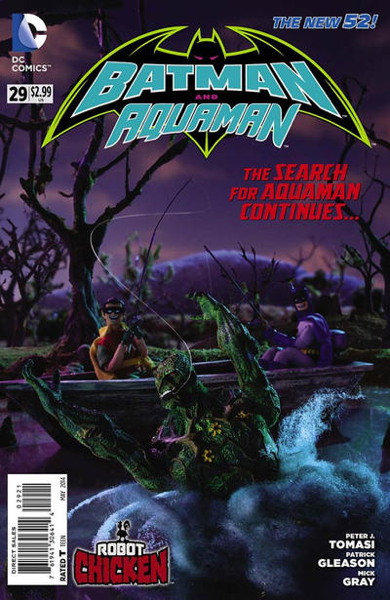
…which I kept because of the Swamp Thing appearance, natch. And while I knew there were more, as part of DC’s attempts to boost orders on their New 52 line, I could not for the life of me remember any of the others. I mean, I know I ordered them and carried them at the previous place of employment, but this was during the lead-up to me opening my own shop, so, you know, maybe I had my mind occupied with other things.
Looking at the cover again reminded me this was a tie-in to the Robot Chicken TV show, which animated action figures in humorously irreverent sketches. (Worth noting that the show itself was inspired by similar “photo-funnies” content featuring action figures in Wizard magazine publications…in fact, writers on the feature went on to create the TV show.)
Specifically, the 2014 covers (of which there were 22(!)) were created to tie into a DC Comics-centric Robot Chicken TV special. And in all this Googling about, I discovered this was the second TV special, with the first in 2012 being advertised by DC then on, far as I can tell, one sole variant cover:
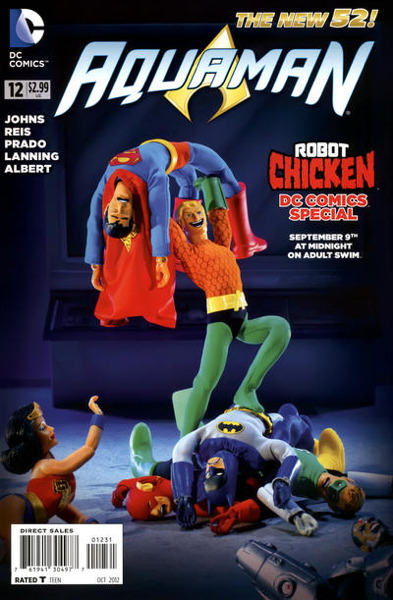
Why just Aquaman? Well, he’s apparently the most hilarious of superheroes, an easy punchline for hack writers.
Anyway, like the MAD variants discussed last time, they got a second run with the aforementioned 22(exclamation mark!) variants in 2014, featuring gags like this:
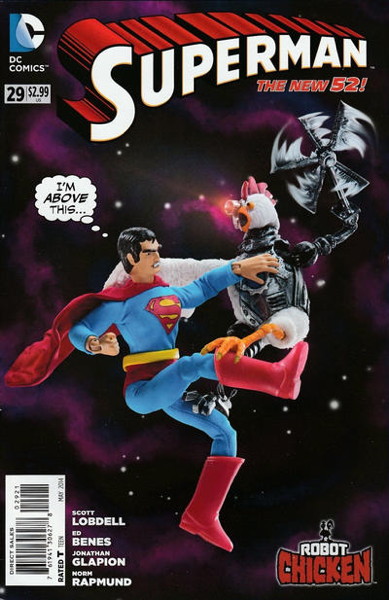
Hm. Well, your mileage may vary I guess, depending on how funny you find the show itself. I’ve never seen it, beyond, I think, some Star Wars gag years ago, and maybe some incidental advertising…but I looked at a few clips on YouTube and it’s fine. And looking at the Wiki entry there’s certainly some impressive voice talent puttin’ in some time there.
But back to the covers: honestly, looking at that gallery I linked above (and will link here again so you don’t have to go searching) I have no recollection of any of these save that Batman and Robin I mentioned. I don’t even remember this Justice League Dark variant:
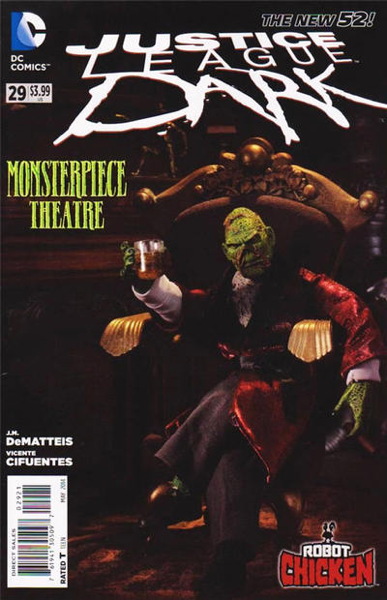
…even though I surely must have kept one for myself. No way that would have slipped past me.
The 2014 books were 1 in 25 ratio variants…again, a silly thing to do, as making these freely orderable may have resulted in fewer inflated orders for comics that may not sell just to get the special cover, and more copies moved to customers who were amused by the variants. But that does explain the low estimated print runs you saw on that gallery page I’m not going to link to for a third time. Some random eBay checking revealed prices in the $10 range, mostly, but some optimistic chap has the Wonder Woman variant at $85.
I think, though, my favorite gag on all these covers was the one used for Aquaman #29:
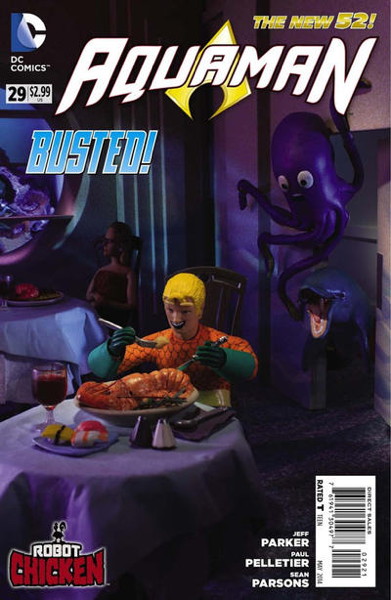
Okay, I admit it, Aquaman is hilarious!
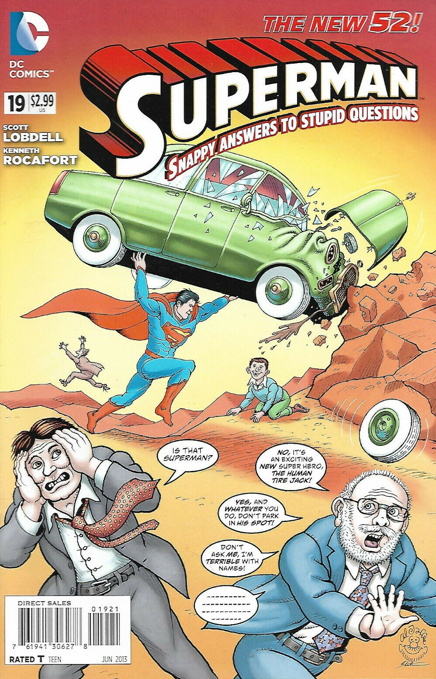
So I think I said at the time, in 2013 when DC Comics was producing MAD Magazine variants for their New 52 line in celebration of April Fool’s Day, that this cover bothered me. I mean, it should have delighted me…it is technically a great drawing, as one would expect from the legendary (and then in his 90s!) Al Jaffee. It’s nicely colored, it certainly stands out on the shelf….
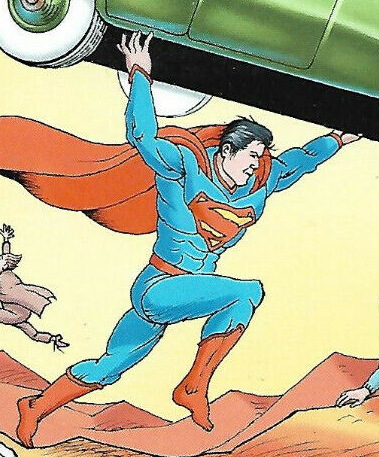
…But what really bugged me is that this wonderful opportunity is marred by burdening Mr. Jaffee with that awful, awful design for Superman’s costume. I know, I know, I’ve gone on about it before, but it baffled man and God as to who actually thought this was a good idea. (As a wise man, me, once said, “if even George Perez can’t make it work….”)
Anyway, Mr. Jaffee did his best, but the costume still looks awkward, unless of course Jaffee himself thought “this costume’s terrible” and played up how terrible the costume was. Thought, I have to admit, when I first saw it, I wondered if he’d been given the instruction “draw a funny Superman cover” and drew Classic Superman, only adding the New 52 outfit’s details later an editor got a look and returned it for regrooving. I mean, I have no idea…the fact that Superman was drawn with obvious trunks, or that the collar seemed a little…off, like it was added after the fact. Or that the body of the costume and even the boots look more like the traditional togs versus the inexplicable armor Supes was saddled with:
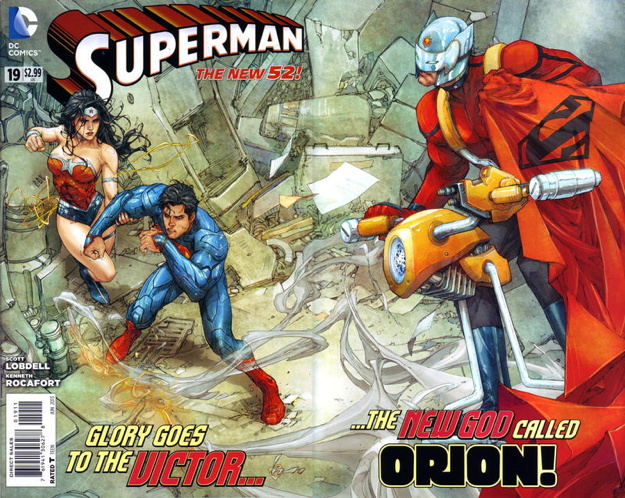
That cover just above, by the way, is the “standard” cover for this issue. However, not satisfied with a MAD variant, DC was running gimmick covers as the “non-variant” edition. In this case, it was the thing DC had branded as their “WTF Certified” covers, a gatefold cover where the front would pose some situation, and then you’d fold out the cover and presumably shout “WHAT THE F–” as you saw the amazing surprise that was revealed. Anyway, more on that when I start my “Gimmick Cover” series, after I’m done (if ever) with Variant Cover-age.
Similarly, poor Sergio Aragones had to do his best with that costume for the Justice League variant:
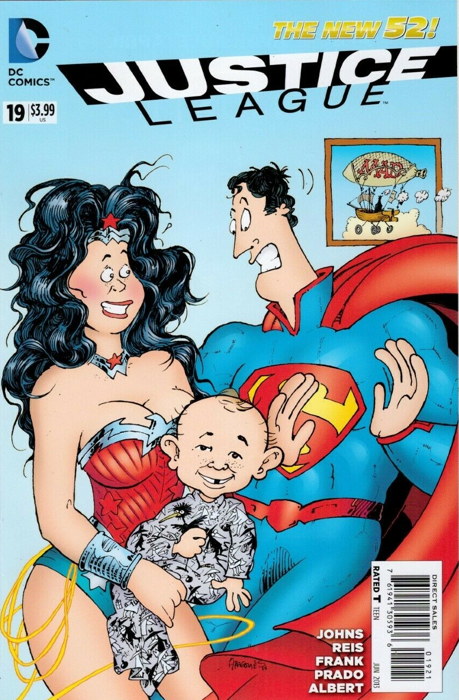
This actually turned out to be the MAD variant for which we had the most requests, and it’s a good thing this was the MAD variant for which we were able to get the most copies, if I recall correctly. A spot check on a number of the MAD variants released that month showed that the majority of them were offered as ratio variants…for every ten copies of the regular cover ordered, a retailer could order one of the special covers.
This always seemed so short-sighted to me. Given that the Justice League variant was offered to retailers…hmm, lemme see how to put this. Retailers were able to order as many copies of that Justice League variant up to their numbers on the lowest ordered New 52 comic for that week. As such, shops ordered as many of that Aragones variant as they did of Sword of Sorcery #7, maybe even raised their orders on the latter to get more of the former, and got a variant that, at least in our case, sold great, even despite that Superman costume. If they’d made the same deal with all the MAD variants, we could have had lots of these to sell:
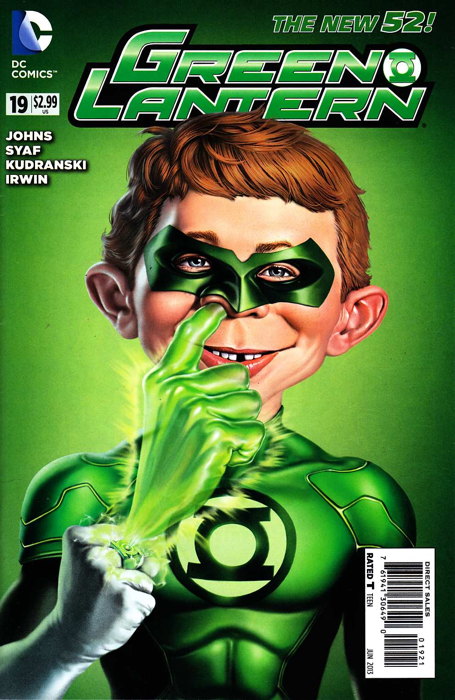
…and believe me, we would have sold plenty.
Now, these MAD variants must have done well, as DC Comics did it again the following year. Alas, not so much since, though when I was tracking down some images on the eBays I noticed that several of these variants have been going for premium prices. Whether that’s a usual thing or just another example of the current collectible-inventing market boosting prices, I don’t know. I did see someone call that Justice League variant a “1 in 10” cover, which is of course wrong. What, on eBay, what a shock.
I do wish something like this was attempted earlier, with some of the MAD artists that I remember from my early days of reading the mag. Not that there was anything wrong with what we got, but imagine a Don Martin Swamp Thing cover, or a Dave Berg Harley Quinn. I tear up just a little thinking of those wonderful possibilities.
(Here’s a gallery of the 2013 MAD variants, and here are 2014’s offerings.)
So this week’s installment of variant cover-age is going to be just a little different. I know I said I was going to take a look at the various New 52 variant covers DC started using to shore up sales once the initial excitement for the new publishing strategy ebbed away.
But more on that later. What I want to touch upon here is the recent report that direct market comic sales in the U.S. are on their way up. A friend (who now has a suspended account there due to stupid reasons involving Twitter’s algorithms) responded on the Twitter thread there asking about the impact of variant covers on that increase, and the response was that the inflated prices on variant covers were not considered, only cover prices on all releases.
Which is fine, of course, those shouldn’t be considered. But there is something to be said about variant covers boosting the amount of money retailers spend on new comic product. I tried to argue the point in that thread, but Twitter’s not a platform for nuance, and things kept getting off track, so let me try again here.
As I’ve mentioned many a time in this ongoing series of variant cover posts (running three-quarters of the year now!), variants exist to improve sales. On the retail end, they offer varying images to appeal to a wider range of customers…if they don’t like one cover, maybe they’ll find the other appealling. Or, more cynically, it’s a way to get a customer to double/triple/quattuorvigintuple-dip and buy more than one cover of the same comic. Or, of course, if it’s a “rare”-ish variant, you can charge a premium price.
What the main focus here, though, is what retailers are buying, and how variant covers can affect those purchasing decisions.
As you may have noticed, or at least noticed me taking about, the collector/speculator demand increasing over the last couple of years. I won’t try to go into the reasons why here (aside from noting that it’s seemingly connected to everyone being stuck at home during peak pandemic times). Demand for anything that even smells of eBay flipability just shot through the roof (which I don’t need as frankly my shop’s had enough roof problems lately). Mostly it’s focused on ’60s Marvel, which is red hot, and the mercurial demand for comics that have even the slightest, and occasionally even spurious, tie-ins to events in the many Marvel TV shows and movies. And don’t even get me started about everyone looking for this comic featuring a character named “Corona.”
Anyway, increased demand from consumers will trigger increased ordering from retailers…and when a portion of that demand is coming from speculators, the temptation is there to go after the manufactured rarity of the ratio variants. You know, where for every 25, or 50, or 200 of something you order, you can order one copy of a special cover.
The argument I was making in the Twitter thread was solely this: an increased incidence of retailers bumping up orders to get ratio variants is a contributor to the overall increase in the direct market. How many times have I been near one of the ratio plateaus when ordering a book, and decided “ah, I’ll get the [x] number of extra copies to get that variant.” And I’m sure I’m not the only one. And with the increase in speculation, the temptation to bump those orders up only increases. Instead of only bumping up, say, three or four copies to get that variant, maybe you’re getting an extra ten since you’re sure whatever you charge on it and sell it for will more than make up for the additional copies.
The specific example I used in that thread was King Spawn #1. Now, I’m just a little ol’ rinky-dink shop. I don’t sell a lot of Spawn normally. I did order a larger-than-normal amount of King Spawn #1 (and the other new Spawn books) because interest seemed to be high in them. But there’s no way, under normal circumstances, I would sell anywhere close to 250 copies, which is what you had to order to get the 1/250 variant cover signed by Todd McFarlane his own self.
As it turned out, I had a customer who really wanted that signed King Spawn, so the amount he prepaid for it essentially covered the the extra expenditure I had to make ordering additional copies of that #1 to get that comic for him. The end result is that I have a boatload of regular King Spawn #1s that I can afford to sell at a special discounted price of a whole 99 cents, to the delight and occasional alarm of my customers.
But that’s neither here nor there. The point is that I ordered waaaay above and beyond what I normally would have ordered of King Spawn #1, for the sake of a variant. That is absolutely, 100% a case of a variant impacting the direct market’s increase in money spent on product. And certainly more retailers ordered 250, or multiples of 250, of that comic in order to get the autograph, even if expected rack sales where nowhere close to what they received.
And yes, that King Spawn stuff all happened this year, and thus not part of the market report, but it simply writ large the sort of impact variants can have on overall sales. It’s easier to see the effect with King Spawn, versus trying to determine how many retailers added a couple of copies here and there to reach much lower ratio variant order plateaus.
On top of that, there are of course the “free-to-order” variants, where you’re second guessing demand on specific covers. Which is hard to do, as Artist [A]’s variant may have been the Hot One on a book last month, but may no longer be the in thing when Artist [A]’s cover for the next book shows up. Plus when there are a lot of variants, you don’t want to miss out on the one people are looking for, so sometimes you perhaps order more than you would have if there was just the one cover. There were cases in the last year or two where Marvel put out comics with literally more variant covers than copies I expected to sell at the shop (cough Eternals #1 cough). For titles like that I certainly didn’t order every cover…but I probably ordered more than I ordinarily would have anyway.
Also there’s ordering extra copies of each variant to accommodate the customers who want more than one cover for the same comic. Another case of the variant boosting sales…especially in the current marketplace, where some customers want every version of each new hot book that comes along.
And really, that’s the only point I was trying to make. The increase in the comics market was contributed to by the presence of variant covers. As I admit in that Twitter thread, I don’t know how much of an impact variants had, but it definitely wasn’t “none.” Again, not talking premium pricing or what have you, just literally sheer numbers of units shipped from distributors to retailers. Seems self evident, but didn’t stop me from going on about it for over 1100 words, did it?
Okay, next time, back to just plain ol’ “lookit dese variant covers.” Thanks for reading, pals.
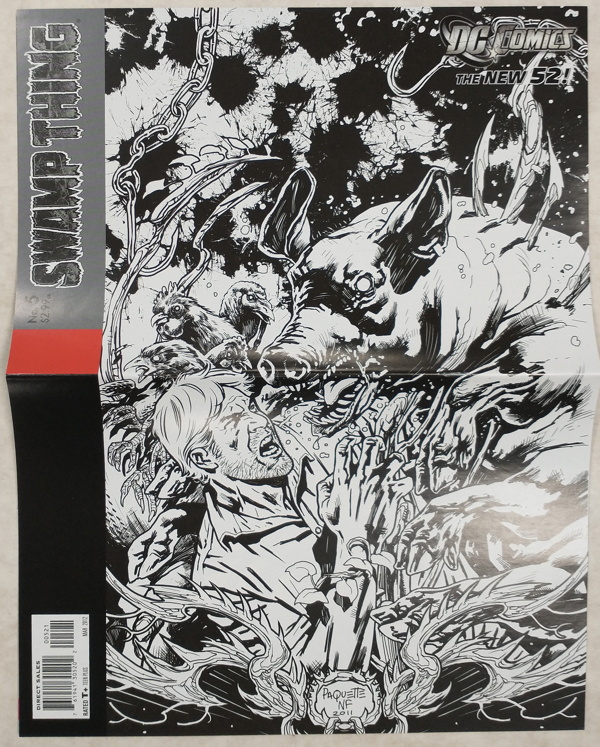
So it dawned on me that I might be opening up bit of a can of worms here, as DC’s New 52 publishing initiative was rife with variant covers. Initially, I was just going to talk about these black and white variants DC offered early on in the initial months of New 52. Like, for example that Swamp Thing one above, which I removed from the formerly vast Mikester Comic Archives to photograph. (Er, pardon the glare.)
As I recalled, several DC titles around this time had this particular style of variant, taking the regular cover, flipping it on its side and stripping it of its coloring. This Swamp Thing issue (#5, March 2012) was offered in a 1:25 ratio, meaning a retailer would have to buy 25 copies of the main cover to order one of these. …Look, I know most of you know how ratio variants work, but someone reading this might not.
In looking at other DC titles, it appears Batman #5 also had a similar variant, but it was a 1:200 ratio book…which makes sense, since Batman is nearly always a top seller for DC. Aquaman #5’s variant, another 1:25. Same with Superman #5. Even Detective Comics #5 was only 1 in 25.
I’m not going to look up every 5th issue of the initial New 52 series to check the ordering plateaus for these black and white wraparounds (and not all of them had ’em…sorry, Blackhawks #5), but I’m going to hazard a guess and say the main Batman title was the one series with the highest “ask” to get that variant. If I’m wrong, I’m sure I’ll hear about it.
These black and white variants are kinda neat. It’s like you’re getting your own reproduction of the original art, in varying stages of development: fully inked, like on the Swamp Thing cover, or just the pencils, like on that Aquaman cover. Which is nothing particularly new or innovative, as black and white “sketch” covers had been a thing already, but by turning it on its side, wrapping the image around the front and back covers, now it more closely approximates the size of what we generally think of original art pages. (Yes, not exactly, hence my use of the word “approximates.”)
I don’t have specific retail stories about these black and white variants, beyond me unsurprisingly glomming onto the Swamp Thing one as soon as I cracked open the Diamond delivery boxes. But what I do want to talk about is DC’s increasing reliance on variant covers over the history of the New 52’s lifespan, as alternate and gimmick covers were prodcuced to shore up the orders after the initial excitement over the relaunch started to fade away.
Variant covers were there from the very beginning of the New 52, with some titles (like Batman and Superman offering other covers based on your lowest DC order for the week. For example, if your lowest order for a DC title coinciding with Batman‘s release was only 20 copies, then you were limited to 20 copies of that one Batman variant. Thus from the get-go, they weren’t even waiting for numbers to drop. They were trying to get you to order more of a comic in which you didn’t have as much faith so you could get yer mitts on more of that Batman variant. Very sneaky.
And there were more variants than that from launch, especially for Batman, not even counting the variations on the several reprintings for this and other New 52 titles (which, as I said last time, is a little outside the range of this overview). I intend to cover more the DC New 52 variants, making this a bit of a series inside the variant cover-age series already in progress, as it’s clear I’m never going to squeeze all these into one post. I mean, I suppose I could, but I don’t really want to be up ’til 4 AM writing a blog post, like I used to do when I was a young and spritely 34 years of age when I started this site nearly two decades ago.
So hang onto your butts, as this variant ride is going to be taking on the New 52 variants over the next few weeks. I of course reserve the right to interrupt the run with breaking variant news, but we’ll see how it goes.
Turan said, in response to my Saturday post about my old mini-comic with the various monster drawings on the back:
“You let pass an opportunity to tie this post in with your recent theme, by calling all of those copies with the personalized monsters ‘variants.'”
I did briefly consider making this explicitly one of my variant cover-age posts, but had opted to not cross the streams, as it were. But, well, the seal has been broken, the connection between the two has been noticed, so I might as well touch on this briefly. Or “briefly,” as the case usually is.
Now, what exactly am I talking about when I say “variant comics?” Okay, fair enough, I’d imagine that’s a question that should have been addressed when I started this series of posts, oh, six months ago. Anyway, when I’m talking about variants, I specifically mean “different versions of the same book offered for sale at the same time, giving consumers a choice.” I’ve more or less followed that here, maybe not strictly exclusively (like the international comics purposefully not offered to the same customers), but that was sort of my overall goal.
Mostly that was to differentiate simultaneously-offered variants from reprint variants, where a sold-out comic would be reissued with a new image or altered coloring on the cover. Like, for example, Identity Crisis #1, where the first print looked like this:
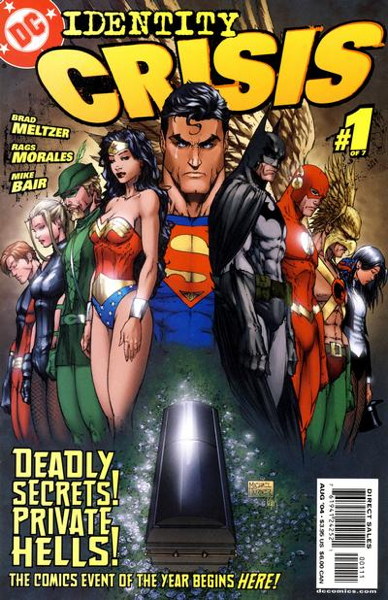
And then the later pressings had changed covers, like this fourth printing:
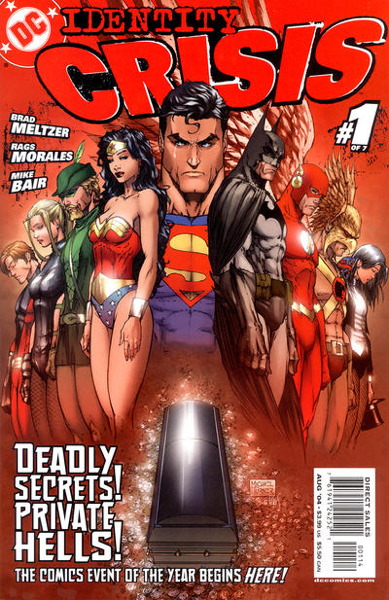
Again, I’ve brought up changes in reprints before here, like for the Robin mini-series. Overall, though, I feel like that’s a somewhat different topic than what I’m covering here. Splitting hairs, I know (and I realize it’s not like the reprints weren’t often offered on the shelves side-by-side with the comics they’re reprinting) but they just weren’t my focus.
Going back to Turan’s comment, where he continues:
“…There was one illustrator who did just that with an issue of BATMAN released with a blank cover–he bought a batch of copies, drew a quick sketch of Batman on each one, and then put them up for sale on eBay as ‘super-rare variant editions,’ priced at thirty dollars apiece. I wonder still how many people fell for this.”
Now “sketch” covers are variant covers, an alternate cover offered at the same time as other covers for the same comic, just with a blank covering made of somewhat-more-amenable-to-drawing-upon paper stock. J. Scott Campbell’s joke “do-it-yourself cover” for Gen13 has become reality, with regular offerings like this:
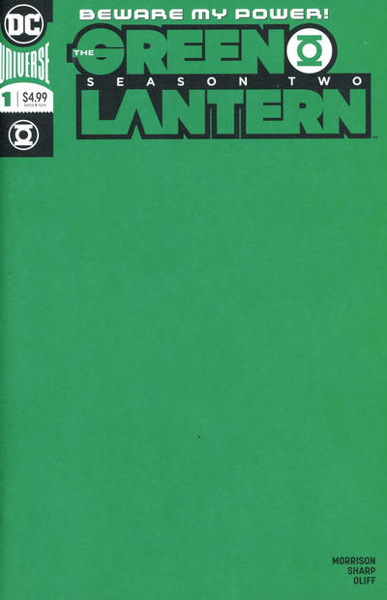
Usually the paper is white, but sometimes the publishers go for a little novelty.
Thus, while blank sketch covers are themselves “variants” for the purposes of my discussion, I am agreeing with Turan (as I think most people would) that the drawn-upon sketch covers being offered on eBay are not “variants” in the same sense. Yes, technically they are additional versions of the cover, but they are not variations simultaneously marketed by the publisher, but rather made after the fact.
Before you logjam my comments section with “what if” and “actually” and “how ’bout” responses, yes, I know there varying circumstances that could allow for a sketched-upon blank cover to be simultaneously offered with the other variants. “Remarked” books with drawings an’ such are frequently available from official sources…I’m just saying, for the purposes of discussion here, at the moment that doesn’t fit the topic I’m interested in discussing. It’s not Law Engraved in Stone, it’s just drawing a line (ahem, so to speak) on “what is a variant” and “what is not a variant” for my purposes. In this instance, “sketched-upon covers” are basically “autographed comics” — yes, they’re all different, but when I’m talking about actual variant comics, you know what I mean.
Now the reason I did all that typing above is to state that my mini-comic with the different monsters drawn on the back…those do count as variant covers. Only one copy of that comic exists with no handdrawn monster, and that’s the one in my collection. As the fella what created, printed, assembled, stapled, and drew upon a few hundred copies of this comic, I can guarantee every one that went out for sale had a different monster on it. Not done after the fact, where they were sold blank and you had to ask me for a monster. You flipped though the rack, found the monster you liked, and you bought a copy. It was offered by the publisher, Full Frontal Harvey, and the creator, me, only with original drawings on the back cover.
If I may be so bold, I suppose it’s like that issue of RAW Magazine with the torn-off corner (and the corners were then switched around so you got a corner of a different copy taped inside):
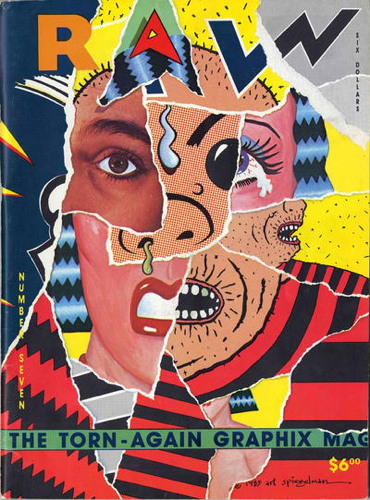
Now you could buy a copy of, say, issue #136 of America’s favorite romance comic Unicycle Tragedy, the extra-sized 17th anniversary issue, off the stand, tear off the cover, and declare it a “variant cover” but nobody’s gonna buy into that. But if the publisher did it and offered ’em up for sale as such, like them wacky RAW folks, then yes, I think that counts as a variant in the sense I’ve been using it here.
That’s a lot of words basically discussing “publisher’s intent” versus “after-market fiddlin’ around. As I said, I’m not the Dictator of Comics (yet) laying down edicts. Just trying to define what “counts” and what doesn’t in my little discussions here.
And speaking of variants: the other day I was going through some stock at the store, and in researching a particular comic I found, I discovered the Grand Comics Database didn’t have an image of it in their system. Well, thanks to me, now they do! …The irony of attaching that bit of business to this post is that the comic may have been a later reprint of the issue for sale in other markets (like the Superman Wedding issue I talked about here). So, possibly closer to Identity Crisis above than to, say, X-Men #1. Oh well, you know where to send the complaints.
So in Monday’s post, where I was talking about variant covers in the “real” non-comics world, I brought up the multiple foil covers used for the Raiders of the Lost Ark novelization. I did say at the end of the post I didn’t think many people were actually buying all the different covers to be completists, but I’m sure it’s not nobody.
Well, Turan swooped in with some bookstore-sellin’ experience, to inform that book publishers weren’t producing multiple covers for their titles as a means of encouraging multiple sales. It was more for encouraging displays from sellers, or for offering more options possibly to attract different demographics by using different cover images/designs.
When you have a hammer, everything looks like a nail, and my comics retailing hammer may have been aimed at those old Raiders books. To be fair to me, I didn’t necessarily say that book publishers were doing multiple covers for the same reasons comic publishers seem to do so…at least, maybe not back then. But discussing those books in close proximity to comics probably implied as such, for which I apologize. But I’m sure there are still book collectors out there snapping up all variations of a new book’s release. C’mon, have you met book collectors?
Anyway, back to the comics…while I’ve been hitting the “variants are there to get multiple sales from the same customer” nail fairly hard around these parts, Turan does bring up other possibilities that I haven’t really considered. There is always the possibility of a comic publisher trying to attract a buyer that may not care for one cover, but definitely like another. I have over the years had customers walk up to the counter buying a comic they wouldn’t normally because of a specific image used on one of the many variants. In fact, a certain still-extant comics blogger of some note may have bought a variant cover or two simply because it had an unnamed swampy gentleman thereupon. So, basically, I should’ve pointed out this reason for variants long ago.
As for variants being issued to inspire creation of in-store displays…well, sure, comic stores could do, and have done, that. I don’t know if that was the explicit intent of comic publishers, but more a natural extrapolation by more clever shops to take advantage of the material offered. I mean, who knows. And again, this is something I’ve sort of done in the past…I mean, I try to display all covers on my racks anyway, but I haven’t gone out of the way to make a specific separate display of just variants in a long time (we did way back when with the 1990s X-Men and Spider-Man #1s). I don’t know if my racking these books like this counts:
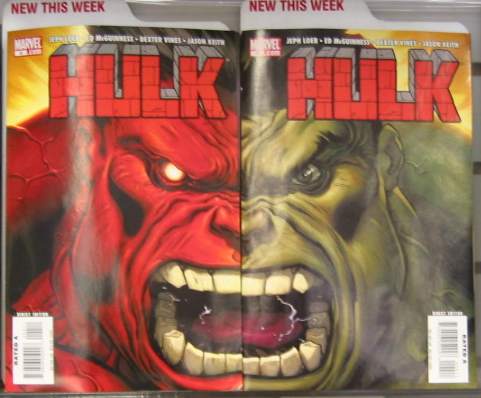
…but boy, it almost got me to buy both covers. I do have to admit I was very tempted to display these covers on opposite sides just to annoy everyone, but cooler heads prevailed.
• • •
To follow up on some other previous posts, I received my newest shipment of weekly Marvel comics from their new distributor Penguin Random House. As I’d expected from how some replacement damages were shipped to me last week, PRH has responded to widespread criticism of their piss-poor packaging and the excessive damages of comics that resulted.
Like Lunar (DC’s distributor) PRH is now packaging their books inside a cardboard box, surrounded by bubble wrap inside another cardboard box. Frankly, the outer box isn’t quite sturdy enough (or large enough to allow for more wrap) to my tastes, but it’s definitely a step up from the last couple of weeks. I did experience some damages, but they were fairly minor dings on six comics, and to be honest I don’t know if these came from their time in transit or before (or as) they were packed in the boxes.
Also, replacements for all of my damages from last week (and there were a lot) arrived early this week. (I initially thought I was missing one, but that’s only because I didn’t recognize the variant cover as being a certain title. AGAIN WITH THE VARIANT COVERS.)
Here’s hoping things continue to improve, and that a certain other distributor who shall go unnamed here will begin to feel at least some pressure to step up their own game. To be fair, I only received two damaged books from them this week, but in the past that just meant I was due for a real problem the following week. We’ll see.
Now I hadn’t heard about this, but on this week’s episode of the Longbox Heroes podcast (being listened to even as I type this), apparently there have been other odd problems with PRH…such as filling an entire order of a book, not with the regular cover, but with the 1/25 or 1/100 ratio variants, which is pretty wild (and possibly quite the windfall for the less scrupulous retailers). I haven’t experienced that particular problem yet, thankfully.
• • •
And now, some good news…the Fabulous Furry Freak Brothers is finally g
oing to series, airing on the free TV app Tubi:
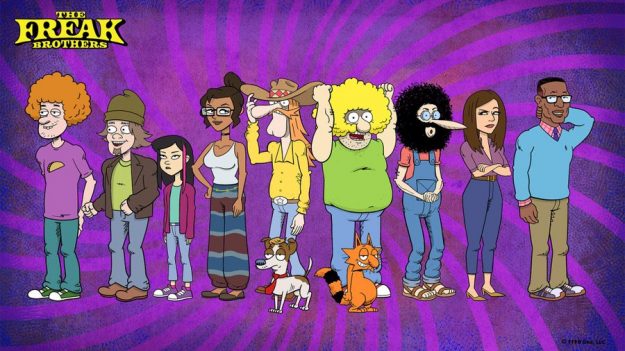
As has been noted, the styles of “Characters Created by Gilbert Shelton” and “Characters Not Created by Gilbert Shelton” do, um, clash quite a bit, but given the premise of the series (the Freak Bros. are spirited away from their ’60s/’70s stomping grounds into the world of today) that seems only fitting. I’ve seen a few of the shorts they did with this voice cast (which is great, by the way) on YouTube, so I’m looking forward to some full-length episodes.
The very first variant cover I remember being confronted with a young’un, where I had to choose “which one do I buy and have to look at for the rest of my life” was the novelization of Raiders of the Lost Ark released in 1981. I can remember the rack at the local Waldenbooks (or was it B. Dalton?) that had multiple copies of this book in a variety of shiny foil coverings. Here are a couple of samples stolen from eBay listings (like, ahem, pretty much every illustration in today’s post):
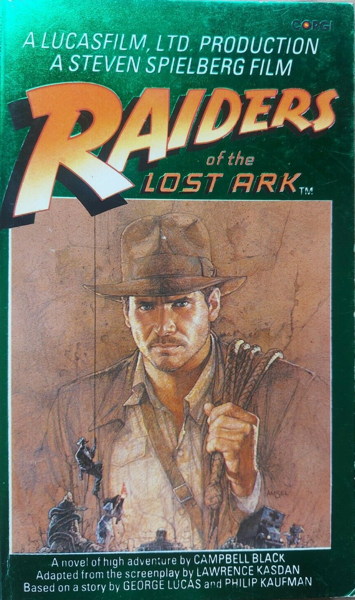
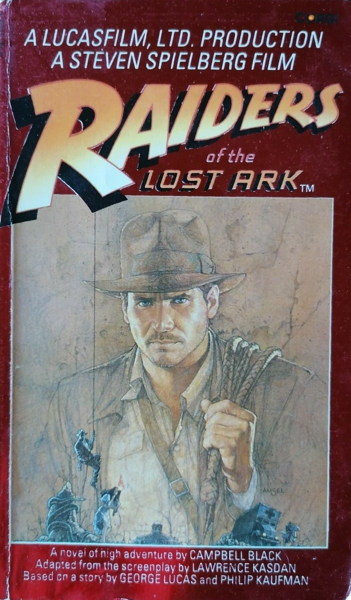
Not pictured is the variation I did buy, which had a silver cover. You know, like “Sterling Silver.” Say, that’d be a good name for a store.
Anyway, it’s weird to see how prevalent variant covers for publications has become, and not just in the funnybook biz. TV Guide had gone fairly hogwild with the variants over the last decade or two, perhaps (like comic books themselves) trying to shore up some dropping circulation numbers by encouraging multiple purchases of the same issue by collectors. (EDIT: Turan explains the reason for variant covers for actual books…more for encouraging in-store displays and appealing to different audiences, not so much for collectors.)
While TV Guide did this for a variety of shows, I’m going to focus on a couple of instances where its variants crossed over with our particular focus here at Progressively Ruinated. I mentioned in my previous post, there was some attempt at outreach by Marvel by including a short comic in a 2000 TV Guide promoting the…well, movie, not a TV show, but whatever. The sample cover I showed you was this:

…but there were five additional covers, each featuring one of your favorite X-Men, and also Cyclops.
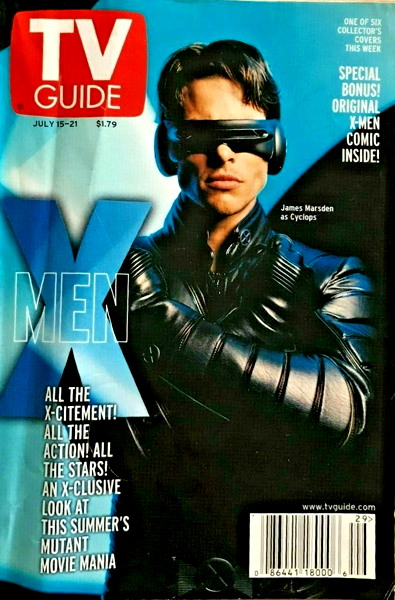
Like I said, I had to hunt down these pics on eBay, where active listings seemed to have a lot of “apple pie in the sky” hopes in their pricing, but looking at the sold listings, they mostly sold for only a few dollars each at most.

The only one that seemed to command any kind of higher price was the Storm cover, and even then it was only about $15. Which doesn’t come as too much of a a surprise…though I’m sure circulation wasn’t what it was, there were still plenty of these printed. And with the comic book tie-in, I wonder how many comic fans squirreled away one (or all six!) of these into their collections.
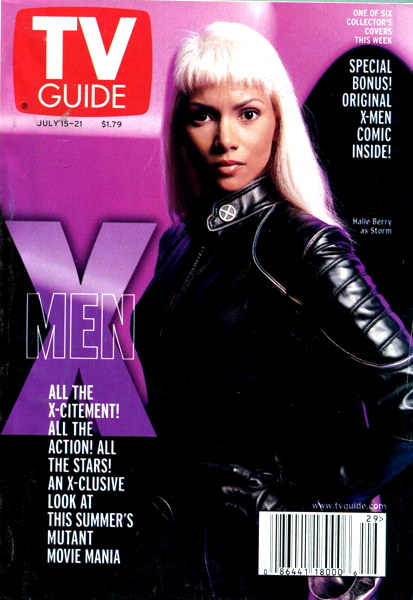
By the way, I did see at least one of these X-Men issues sealed in a graded slab, and it was the Jean Grey cover:
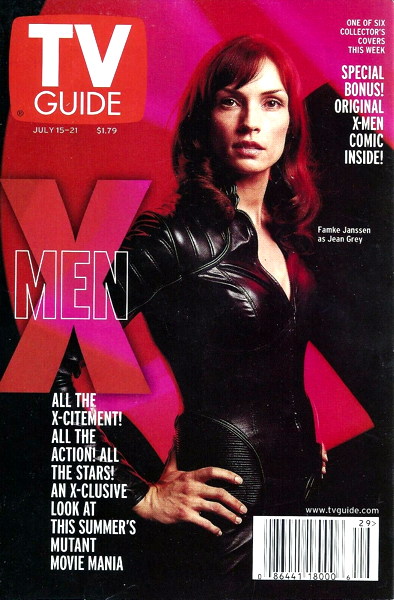
And all I have to say about the Wolverine cover is “just look at that cherubic face.”
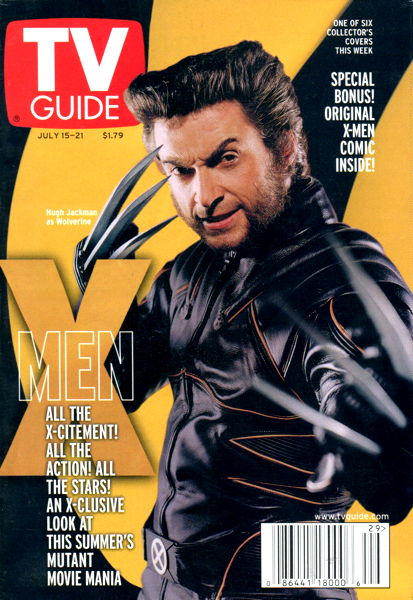
Now the comic inside was intended to get people interested in the X-Men comics, and while it certainly put comics in front of a lot of faces, I have no idea how effective it was. I know at the time, like I said in the previous post, comic folks weren’t terribly impressed with the included story and its potential to attract new readers. I barely remember it myself, so I can’t speak personally as to how good or…less good it may have been. I do know I never had a single person (or even a married one) come into the shop and say to me “wow, I loved that X-Men story in TV Guide, gimme more of that!”
If you were a person who was turned onto the X-Men by the comic in this issue, and statistically speaking I feel like there must be someone…and you’re reading this blog, which is statistically unlikely, let me know! That X-Men comic was a lot of people’s first X-Men comic, and it was probably almost as many people’s only X-Men comic. I want to know who continued from there.
Another TV Guide comic book tie-in with variant covers was 2001’s Smallville issues, featuring four (connecting) covers by Alex Ross. And inside was a short Smallville comic story. Here’s the first cover, featuring Tom Welling as Clark Kent:

…and here’s a pic of all four covers together (this one grabbed from Reddit, I think):
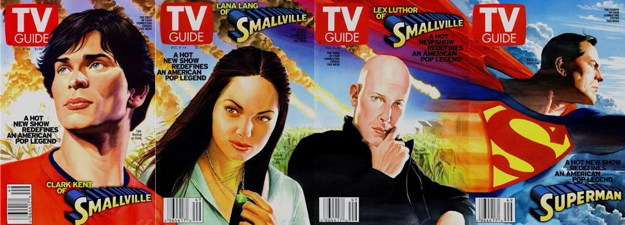
I do recall a small amount of chatter at the time from Superman fans picking up copies of this issue, and trying to get a complete set. I even grabbed a copy, longtime Superman fan that I am, opting for the fourth cover with the Man of Steel himself. Perhaps inadvertently wisely prescient: no Chloe cover.
It’s the Smallville issues I’ve seen more often turning up in collections (though it’s been a while). I can’t ever recall seeing an X-Men cover show up in someone’s hands, looking to sell. A look on eBay shows, again, some high hopes for active listing pricing, but virtually no completed sales. Either they’re all priced too high or nobody wants them. And given that the show is long off the air, and basically supplanted by other superhero shows, maybe that’s not a surprise. Or maybe all the Smallville fans got theirs already and ain’t giving them up. I mean, I still have mine.
It’s be a long time since I’ve paid any attention to TV Guide, and with the increasing emphasis on streaming on-demand television, I’m sure its relevance is hurting a bit. A look at this archive of TV Guide covers shows they did variant covers as last year (not for any comic book related properties that I see), but none for this year as of yet. I was also semi-surprised to see the mag is biweekly now.
It is interesting to see how other media have latched onto the variant gimmick to get increased sales…possibly inspired by comics, but, like that Raiders of the Lost Ark book, not necessarily. But magazines, books, CDs and records…all going for that collector dollar by feeding on completist impulses. Even though I have a hard time picturing someone grabbing one of each of those Raiders books…but I bet someone did.
I’ve been trying, for the most part, to focus on variant covers that were available simultaneously to the same market, forcing customers to chose to buy one or the other (or the other or the other or the other, if it’s a Marvel book). Or, preferably, to buy every offered cover, and hope the excess of choice doesn’t turn in a no-sale.
For today’s variant cover-age discussion, I just wanted to point a virtual index finger at U.S. comics printed in distant lands with cover prices in their currencies. Which bums me out just a tad as I had a number of UK editions of Silver Age Marvel books show up in a collection a while back.
Said collection came from a lady had been a child in England during the 1960s, and had bought her fair share of funnybooks off the stands there at the time. When she came to the U.S., the comics made the move with her, and she held onto them for all the time before deciding to bring them to me for sale. Lots of Marvels (Avengers and Fantastic Four, mostly, including the first appearance in FF of the Black Panther), all preprinted with the pence price, like so:
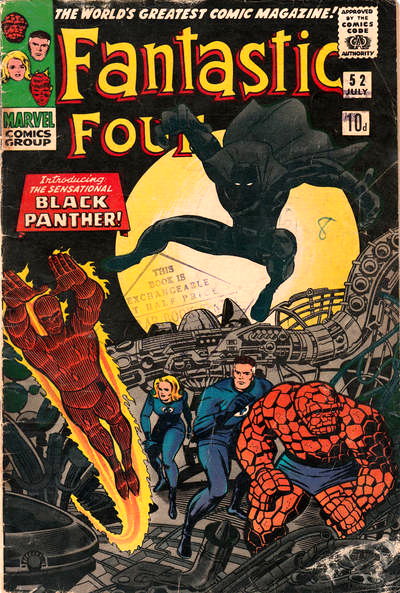
And for comparison, the U.S. edition:
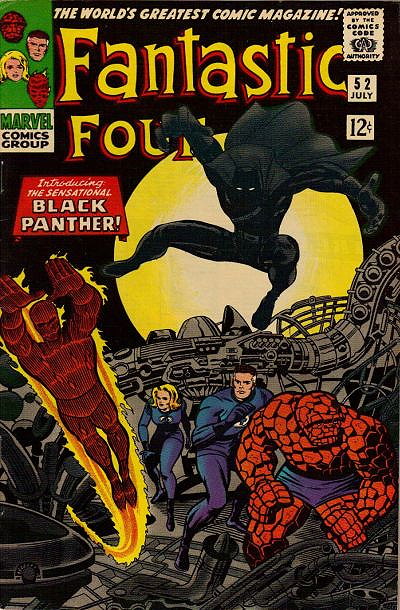
The collection also contains a number of DCs, mostly Flash and Green Lantern, that, instead of already having the proper price in the local currency printed thereon, were ink-stamped instead:
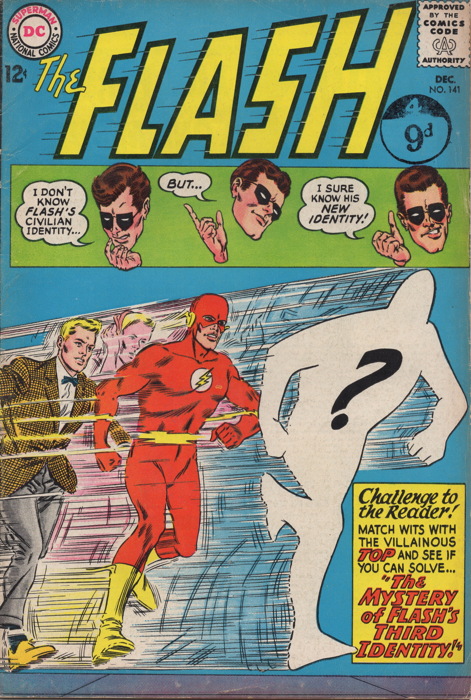
A few of the Marvels in the collection were stamped like this, but mostly they were printed with the alternative coinage.
Anyway, the reason I said my having these “bums me out” is because the Marvels in that collection, like pretty much any Silver Age Marvel that I acquire, sold almost immediately. I don’t have them in my hands for direct inspection, requiring me to once again mooch off the Grand Comic Database for a couple of the above images. (The Flash, I still had floatin’ around.) If memory serves, the comics were identical to their U.S. counterparts save for the pricing. The indicia, the block of text inside with all the copyright and printing information, I think was the same, but I’m not 100% on that.
To the best of my iknowledge, the two versions were printed and released at the same time, so technically I suppose any jetsetting kid could have the quandary of either buying the one with the American price or waiting for the trip overseas to buy the British version. But by and large, the comic marketing twain did not meet.
The main point I wanted to make about these comics printed with the UK prices is the change in perception towards them that we’ve seen over the years. For the longest time, a UK edition, identical in every other way, was deemed “inferior” to the U.S. edition in the collector’s market. It wasn’t the “real” version, or simply a “reprint” and thus commanded less demand and lower prices, generally speaking.
Well, as we’ve seen in recent years, especially in the last year and a half, the demand for anything that can be deemed “hot” and “collectible” has absolutely skyrocketed. Just the other day I was looking at one online marketplace, shocked at the prices for old Comic Reader fanzines…things I used to buy in bulk at a dozen for ten bucks, now being offered at $80 to $150 each. Whether they’re realizing those prices with actual sales, I don’t know, but it’s definitely part of how things are trending of late.
When that collection of UK books came in, my research (along with some consultation with former boss Ralph) revealed that most UK editions are now pricing at least equal with their U.S. counterparts, if not more. And a quick look at eBay and elsewhere can see them being hyped as “RARE!” “VARIANTS!” to attract eyeballs. Quite the change from the vague disdain (at worst) to mild amused novelty that the UK editions used to receive. I mean, I guess they’re in a bit shorter supply than the U.S. comics, since fewer copies were required for the UK newsstands. And they are harder to find in the States, since they were never distributed here. It’s still strange to see them ballyhooed like this.
Which of course had me wondering if the versions printed with U.S. prices are the oddity in the UK. My guess is probably “not as such,” giving the larger print runs of the American editions and the likely flow of books from here in the UK market via collectors. But I bet someone out there can set me straight.
So there you go…yet another type of variant you need to worry about. Didn’t have much to say about it, aside from the nearly 800 words above, but I found the shift in collecting perception interesting. And it wasn’t just the current rush for collectibles we’re seeing that did it, as I acquired, and blew out the door, all these UK Marvels before the madness really set in.
Not sure what’s next in the ol’ variant cover-age, aside from continuing to make the phrase “variant cover-age” a thing, but I appreciate you reading all these and I hope I can cook up more next week!
So back in this post I made note about publishers polybagging for safe display comics containing adult material. Specifically I was talking about Barry Blair’s Leather and Lace from 1989, but I also made note of Howard Chaykin’s very adults only Black Kiss from the previous year.
Now I don’t recall if Black Kiss was the first modern(-ish) comic book to be bagged for content reason. I’m reasonably certain there had been comics pre-bagged before (were there 3-D comics that were bagged with glasses? there must have been) but I feel like the polybag covering of Black Kiss was enough of a novelty to drive attention to it. I mean, even more attention above and beyond “dirty comic by Howard Chaykin.” (And of course the factory-bagging continued some non-adult issues of note later on.)
Now Black Kiss didn’t have any variants as such for its individual issues, which may have you wonder why it’s in this variant cover-age post. Gettin’ to that, honest, but it does have to do with what eventually happened with some of the Black Kiss covers. A couple of issues in, the covers on the title started to get a tad too racy for general display in a store, so rather than see them relegated to that curtained area in the back of the shop behind the shelves of Rolemaster games and Ral Partha miniatures, an opaque overlay was inserted into the bag with the comic to cover its shame:
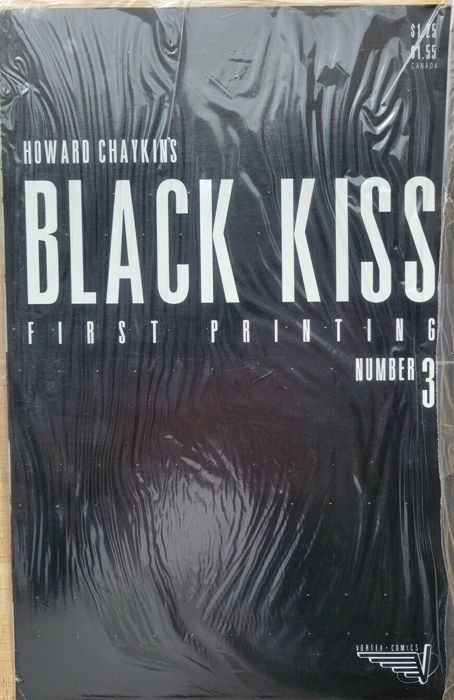
(Image liberated from an eBay auction, not because I couldn’t scan it if I had a sealed one, but because I don’t have a sealed one…all my copies of this are opened, though I still retain those card inserts because I’m a weirdo.)
Now the reason I mentioned all that is this style of protective covering was an inspiration later on for current marketing gimmicks in relation to, yes, variant covers. Take, for example, the currently-in-release series The Last Book You’ll Ever Read from Vault Comics. Each issue so far has had multiple variant covers…a couple of which are laid bare to public viewing, acceptable for all ages, and one filthy dirty filthy variant sealed for America’s protection in a polybag and opaque cardboard covering:
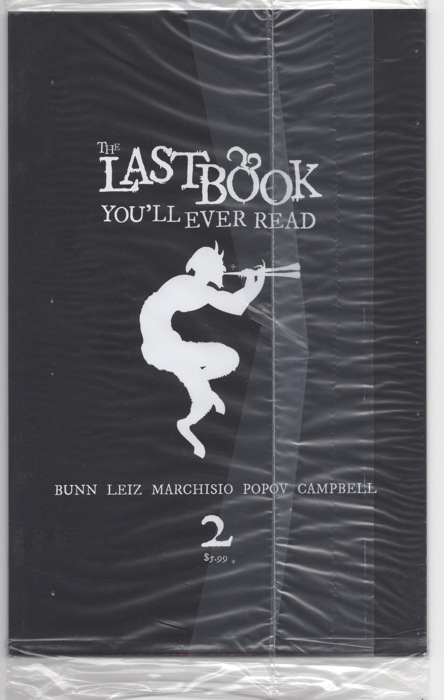
This of course isn’t the only comic to use this strategy of “what you see is what you got, what you don’t see might be hot!”* to entice readers into picking it up and ripping open the package to see what’s been hidden from them. Preferably after they pay for it, naturally. The most famous recent example is the uncomfortably-titled Sex Criminals:
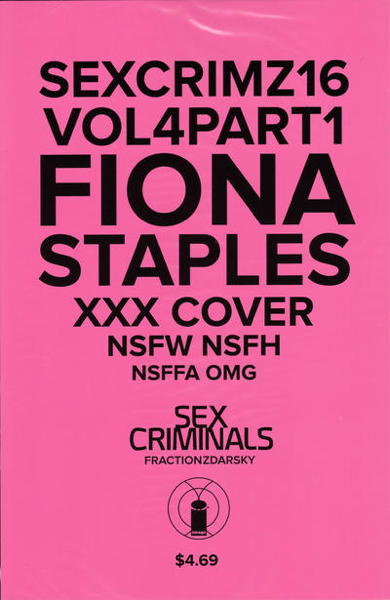
…which went all out on their bags to get you to drop the extra 70 cents to buy this version instead of the plain ol’ ordinary covers recommended by schools and churches.
And other comics are doing this, too…the slightly less uncomforatbly-named Money Shot from Oni Press started with the bagged and boarded naughty cover variants relatively recently. And the Bettie Page comics from Dynamite are eschewing the board altogether and issuing “black bag” variants, where, as the name implies, the bag itself is opaque and you can’t see Bettie…I don’t know, gardening on that particular variant. I bet that’s it, she’s probably gardening.
There have been the occasional packaging issues with these variants in the past. I think there was a Sex Criminals where the bag was insufficiently opaque or manufactured in some way that inadvertently revealed the cover. Plus, there was at least one comic recently where the covering board was inserted on the wrong side of the bag, leaving the sexy side unveiled for all. (I honestly can’t remember which comic that was now…was it Money Shot? “Here, let me type ‘money shot’ into Google….” “MIKE, NO”)
It’s a little amusing that a protective packaging strategy from an era where comics where under fire from folks “concerned” for their content (but mostly just trying to get their names in papers by hitching themselves to something popular) continues today as part of a marketing gimmick to sell alternative versions of comics for higher pricetags. Not that it wasn’t a gimmick in the first place, but it certainly saved us a bit of time at the shop having to bag ’em up ourselves. Having an open Black Kiss, or Faust, or something similar, just sitting on the shelf within the grasp of kids would have been a bit much. It became enough of an issue that “privacy bags” (black with a small window at the top for logos) began to be marketed for retail use.
Now, does the “bagged adult variant” thing work, saleswise? …I’d think “yes,” more or less. For the most part, when people have titles that have these variants on their pull lists at my shop, they specify the bagged editions. When I have the Bettie Page black bag variants available, they sail off the racks, I’m guessing to gardening fans. By and large, they do what they’re supposed to do, and that’s grab attention. But not too much attention from the wrong (i.e. too young) eyes, which seem to just pass right over them in favor of more dynamic covers on Amazing Spider-Man or whatever.
And that’s another variant style down, after nearly six months of talking about ’em (almost) every Monday! I’m not done yet, so tune in next Monday to see what else I’m cooking up. If you have anything to add to today’s discussion, or have a request, be sure to let me know!
* Attributed to Jamie Farr, from an episode of The Gong Show, according to my old pal Rob. Never heard it for my own self, but surely it must be true as it’s too good not to be.
The only platinum edition comic I personally own is, as should come as no surprise, this “Collector’s Edition” (no, really, it is, it says right at the top) of Swamp Thing #140 (March 1994):
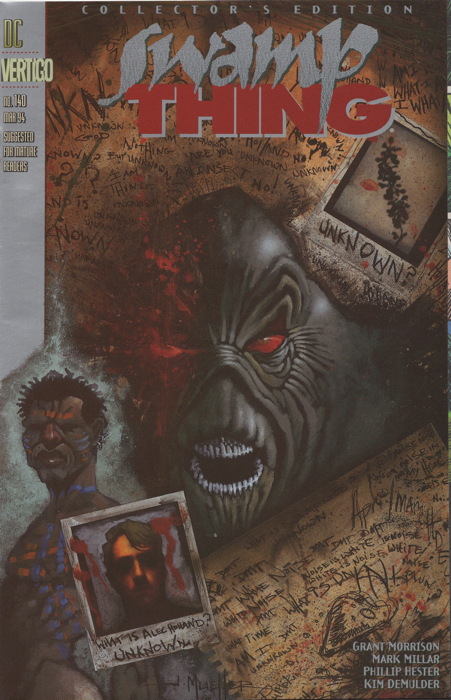
In addition to having the silvery-ink sidebar, logo, and other cover highlights, this edition replaced the ad normally on the back cover with this Swampy image by Phil Hester:
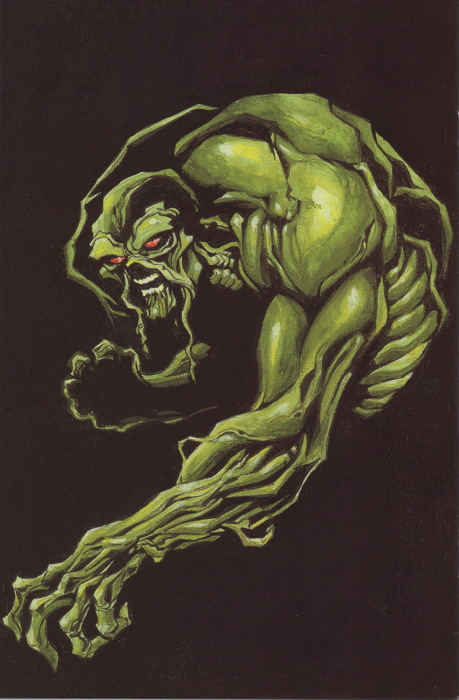
You’ll have to forgive me, it’s been (urgh) about 27 years since I got my mitts on this particular variant, so I forget the exact details surrounding its release. I thought maybe it was a Vertigo anniversary thing, or commemorating some soft relaunch of the imprint, or something along those lines. But no, a little digging showed DC doing a number of platinum editions around this time, just signifying some new notable title launch or storyline or whatnot.
Generally distributed one per store, these platinum variants carried some secondary market value as I vaguely recall, though a look at eBay nowadays shows plenty of copies of most platinum editions available for sale, and mostly not very expensive at that. Someone’s got a Books of Magic #1 (May 1994) platinum edition up for a Buy It Now of five bucks, as I type this.
To be fair, there were a lot of platinum editions in the Vertigo line. I’d remembered that Books of Magic issue, and, oddly enough, the platinum edition for the slightly more obscure Extremist #1 (September 1993). But I forgot about this particularly nice-looking platinum Black Orchid #1 (September 1993).
Of course it wasn’t just the Vertigo titles that got this treatment, however. Check out this platinum cover for Milestone Media’s Hardware #1 (April 1993) that I don’t think ever knew existed:
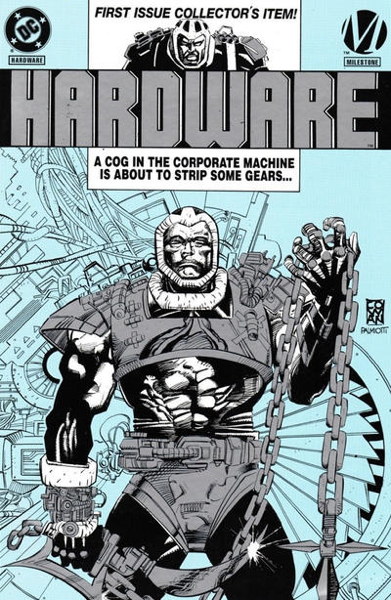
And there was a platinum edition of Static #1 (June 1993) as well.
Most famously, though, and I don’t know why I didn’t put the Vertigo “platinum” trend at DC together with this in my head, were the Death of Superman-related “collector’s editions.” There was of course the actual Death of Superman issue, Superman #75 (January 1993), in a black bag that replaced the bloody “S” logo with a silvery one, and slapped the words “PLATINUM EDITION” along the bottom:
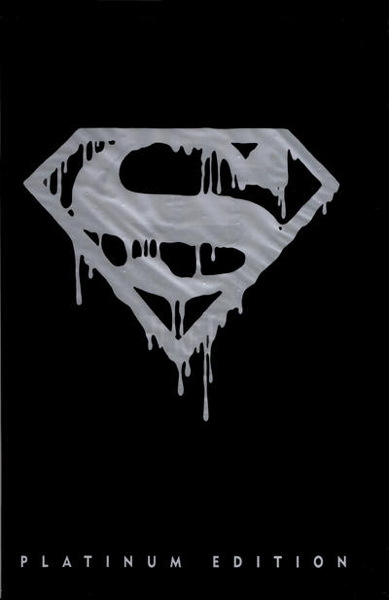
A search of copies on eBay showed plenty of graded ‘n’ slabbed copies out of the polybag*, and the front of the comic itself looks no different from the platinum one. However, the back covers feature a big white space and a serial number:
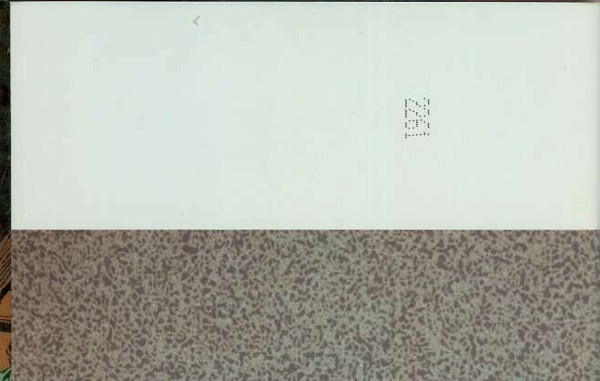
The Grand Comic Database entry states these were possibly numbered between 1,000 and 11,000, though there’s been no official confirmation from DC. This excerpt from a retailer letter I posted a couple of years back definitively states that it was a limited edition of 10,000. Also, you had to send in your business card and a copy of your resale certificate. Here, I’ll save you a click and just post the scan again:

Back in the old days, you had to work for your special platinum variants, they weren’t just handed out to stores willy-nilly!
DC later released a platinum edition of the white-bagged Adventures of Superman #500 (June 1993), which as you may remember kicked off the whole “Return of Superman” hoohar.
Black-bagged instead of white, silver non-bloody “S” logo on the front, “PLATINUM EDITION” along the bottom…don’t get it mixed up with the #75 above!
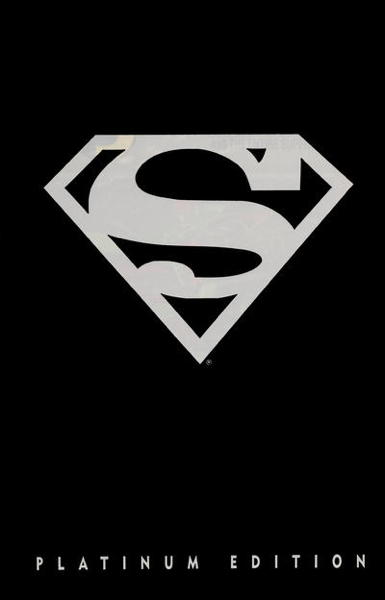
Unlike the actual cover of #75, which isn’t immediately apparent that it’s any different from the regular edition unitl you turn it over and see the serial number, ADV500 is instantly identifiable with its…whatever that color is cover instead of black:

I mean, is that “light mint?” What would you call that? Or is that just white in weird lighting? I honestly can’t tell, and it could just be my eyes. And it’s been so long since I’ve seen one in person I can’t tell you from memory.
Anyway, don’t think this one was serially numbered, at least as far as I can tell. And I think this was just sent out to folks who carried the comic, as perhaps DC didn’t want to further aggravate retailers already stuck with copies by making them jump through hoops to get…yet another copy.
I’m sure I missed mentioning a few…I wasn’t trying to be absolutely comprehensive here, but perhaps I can append a list later of all of DC’s platinum editions if necessary. But man, considering I didn’t even know about a couple of them is going to make it tricky to track down. And I didn’t even touch on platinum editions for other publishers. But it felt like such a weirdly DC thing I decided to just focus on them.
Plus, I got to show off my Swamp Thing comic.
* And yes, there’s perhaps some minor debate over the value of bagged comics and their opening or not opening thereof. I know the price guide allows for a bagged comic to be neatly opened and all contents retained to keep that high price and grade, but in the wild…man, sealed copies always sell for more than even the most neatly-opened copies. What can I tell you.
« Older Entries
Newer Entries »















































